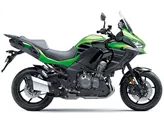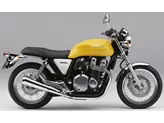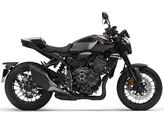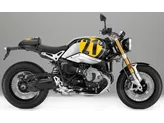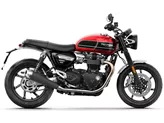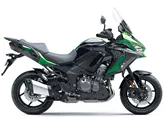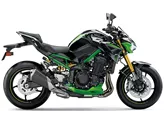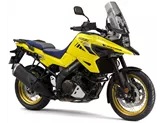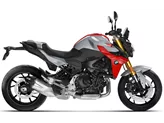Kawasaki Versys 1000 2016 vs. Kawasaki Z900 RS 2018

Kawasaki Versys 1000 2016

Kawasaki Z900 RS 2018
Genel bakış - Kawasaki Versys 1000 2016 vs Kawasaki Z900 RS 2018
The Kawasaki Versys 1000 2016 and the Kawasaki Z900 RS 2018 are both impressive motorcycles with their own unique features and strengths.
Starting with the Kawasaki Versys 1000 2016, it boasts a sporty look and a comfortable seating position, making it suitable for long rides. Its in-line four-cylinder engine delivers a powerful and refined performance, with an engine power of 120 HP and torque of 102 Nm. The transmission is chain-driven, and it has a displacement of 1043 ccm. The suspension system includes an upside-down telescopic fork at the front, with adjustable compression, preload, and rebound settings for a customized riding experience. The rear suspension also offers adjustment options for compression, preload, and rebound. The aluminum frame provides stability and durability, while the double disk brakes with four pistons ensure efficient stopping power. The front and rear tires have a width of 120 mm and 180 mm, respectively, with a diameter of 17 inches. The wheelbase measures 1520 mm, and the seat height is 840 mm. With a kerb weight of 250 kg (with ABS), it is slightly heavier compared to other motorcycles in its class. However, it compensates for this with a generous fuel tank capacity of 21 liters, allowing for longer rides without frequent refueling.

Kawasaki Versys 1000 2016
On the other hand, the Kawasaki Z900 RS 2018 offers a powerful and smooth riding experience. It features a comfortable seating position and easy handling, making it suitable for riders of all skill levels. The in-line four-cylinder engine delivers a strong performance, with an engine power of 111 HP and torque of 98.6 Nm. The transmission is also chain-driven, and it has a displacement of 948 ccm. The front suspension consists of an upside-down telescopic fork with adjustable compression, preload, and rebound settings, while the rear suspension offers adjustment options for preload and rebound. The frame is made of steel, providing strength and stability. The double disk brakes with four pistons ensure reliable braking performance. The front and rear tires have the same dimensions as the Versys 1000, with a width of 120 mm and 180 mm, respectively, and a diameter of 17 inches. The wheelbase is slightly shorter at 1470 mm, and the seat height is 835 mm. With a kerb weight of 215 kg (with ABS), it is lighter compared to the Versys 1000. However, it has a smaller fuel tank capacity of 17 liters, which may require more frequent refueling during long rides.
In terms of weaknesses, the Kawasaki Versys 1000 2016 has a windshield that can only be adjusted when stationary, which may be inconvenient for some riders. Additionally, the gear indicator is not included as a standard feature and requires an additional cost.

Kawasaki Z900 RS 2018
On the other hand, the Kawasaki Z900 RS 2018 does not have a shift assistant, which could be a drawback for riders who prefer this feature. It is also slightly heavier compared to other retro bikes in its class, which may affect maneuverability. The seat is reported to be a little too soft for long tours, and there is no wind protection, which could be a disadvantage for riders who prioritize comfort and protection from the elements.
In conclusion, both the Kawasaki Versys 1000 2016 and the Kawasaki Z900 RS 2018 offer their own unique strengths and weaknesses. The Versys 1000 excels in its sporty look, comfortable seating position, powerful engine, and adjustable windshield, while the Z900 RS stands out with its powerful engine, good looks, comfortable seating position, and balanced handling. Ultimately, the choice between these two motorcycles depends on the rider's preferences and priorities.
Teknik Özellikler Kawasaki Versys 1000 2016 ile karşılaştırıldığında Kawasaki Z900 RS 2018
Karşılaştırıldığında Artıları ve eksileri
Karşılaştırıldığında Artıları ve eksileri
Kawasaki Versys 1000 2016

Kawasaki Versys 1000, tasarim açisindan öyle görünse bile tamamen yeni bir model degildir. Görünüm, iki sivri far ve öndeki birçok kenar ile mevcut, agresif Kawasaki çizgisine çok ustaca uyarlanmistir. Teknik olarak ise dikkatlice ama oldukça makul bir sekilde yükseltilmistir. Iki ilave beygir gücü, gücü 120 bg'ye çikariyor ve bu da muhtesem sirali dört silindir özellikleri sayesinde mükemmel bir sürüs sagliyor. Sasi bir Kawasaki'nin sportif taleplerini karsilarken, ergonomi ve rahat oturma pozisyonu yine de uzun yolculuklara izin veriyor - tipki büyük bir enduronun yapmasi gerektigi gibi. Pannier seti, üst çanta, isitmali elcikler ve ek farlar gibi kullanisli aksesuarlarla Versys 1000 ciddi bir uzun mesafe turcusu haline gelir - nispeten düsük taban fiyati bu hileleri oldukça uygun hale getirir.
Kawasaki Z900 RS 2018

Dört silindirli motoru ipeksi bir sekilde pürüzsüzdür ve ayni zamanda kaskinizin altinda siritmaniza neden olacak kadar güç saglar. Ayrica manevra yapmasi çok kolaydir, bu da onu mükemmel bir günlük banliyö ve hafta sonu ikonik bir eglence motosikleti yapar. Görünüm, klasik tasarim ve modern detaylar arasinda mükemmel bir denge kurarak uyumlu bir retro paket olusturur ve ayni zamanda Kawasaki tarihine layik bir övgüdür. Sik bir görünüme sahip harika bir çiplak motosiklettir.
Fiyat Karşılaştırması Ortalama Piyasa Fiyatı Kawasaki Versys 1000 vs Kawasaki Z900 RS
There are a few key differences between a Kawasaki Versys 1000 2016 and a Kawasaki Z900 RS 2018. In terms of price, the actual average price of a Kawasaki Z900 RS 2018 is about 24% higher. A Kawasaki Versys 1000 2016 experiences a loss of 1,080 USD in one year and 930 USD in two years of ownership. This is offset by a loss of 900 USD and 1,070 USD for a Kawasaki Z900 RS 2018. Compared to Kawasaki Z900 RS 2018 there are less Kawasaki Versys 1000 2016 bikes available on the 1000PS.de Marketplace, specifically 7 compared to 28. It takes less time to sell a Kawasaki Versys 1000 with 88 days compared to 154 days for a Kawasaki Z900 RS. Since model year 2012 1000PS.de editors have written 19 reviews for the Kawasaki Versys 1000 and 26 reviews for the Kawasaki Z900 RS since model year 2018. The first review for the Kawasaki Versys 1000 was published on 11/7/2011 and now has more than 8,400 views. This compares to more than 63,700 views for the first review on Kawasaki Z900 RS published on 9/6/2017.



